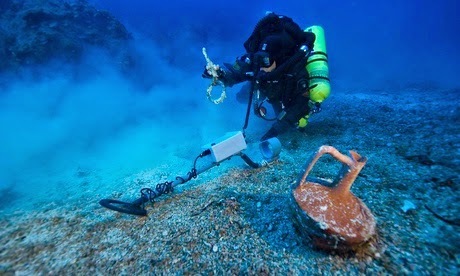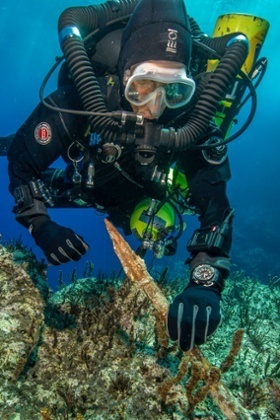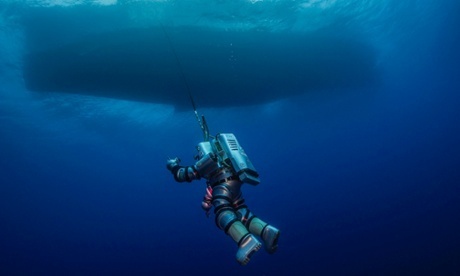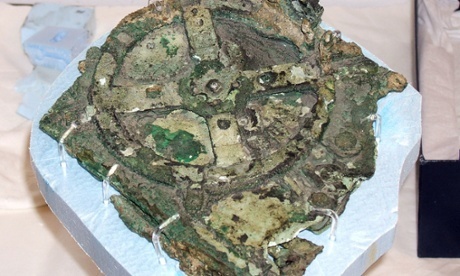Scientists hope to unravel mystery of the ‘Titanic of the ancient world’
 A diver approaches an almost intact pitcher at the site of the underwater exploration near Antikythera island in Greece. Photograph: EPA
A diver approaches an almost intact pitcher at the site of the underwater exploration near Antikythera island in Greece. Photograph: EPA They call it the Titanic of the ancient world – a luxury liner dating from before the Roman empire. Now divers and archeologists, who have completed a third season on this famous wreck off the remote Greek island of Antikythera, hope that their latest finds can at last help settle speculation surrounding the ship, its passengers and crew.
After mapping the treacherous site, the international team hope that a small but carefully selected haul of artefacts on the huge site more than 55 metres beneath the surface can help unravel the truth about a vessel that may have been 50 metres long.
The inner workings of the Antikythera mechanism.Antiquities rescued on this visit include an intact table jug, bronze ornamentation that was probably part of a bed, a 2-metre piece of a bronze spear, weighing more than 10kg and most probably part of a statue – perhaps of a warrior or the goddess Athena – and a bronze rigging ring with fragments of wood still attached.
 A diver holds a bronze spear at the site of the Antikythera wreck. Photograph: Brett Seymour/AP Scientists also plan to trace the origin of the lead in huge anchors and hull sheathing to help determine whether the ship was of Italian, Roman or Hellenic origin. And they want to check DNA in the ceramic jug, one of nearly 50 found by various explorations of the wreck dating back to 1900, to establish whether it was carrying grain. Grain and stone carriers were the biggest sea-going vessels more than 2,000 years ago.
A diver holds a bronze spear at the site of the Antikythera wreck. Photograph: Brett Seymour/AP Scientists also plan to trace the origin of the lead in huge anchors and hull sheathing to help determine whether the ship was of Italian, Roman or Hellenic origin. And they want to check DNA in the ceramic jug, one of nearly 50 found by various explorations of the wreck dating back to 1900, to establish whether it was carrying grain. Grain and stone carriers were the biggest sea-going vessels more than 2,000 years ago.Even the first finds, made by sponge divers blown off course well over a century ago, included spectacular treasures – including enormous statues, and the elaborate Antikythera mechanism, a complex early “computer”, tracking cycles of the solar system. Many of the artefacts are now in the National Archaeological Museum in Athens.
Examination of hull remains, recovered in 1976, suggest that the planks, 11cm thick even in a shrunken state, come from a ship that was 15-20% bigger than any wreck of similar age. The only wrecks that come close, according to Brendan Foley, of the Woods Hole Oceonographic Institution in Massachusetts, were the pleasure barges of the emperor Caligula discovered in Lake Nemi, Italy, in the 1920s and later destroyed in an allied bombing raid during the second world war.
“I have personally investigated 40 or 45 shipwrecks throughout the Mediterranean and never seen one like this. It is full of luxury goods. It is an enormous ship, massively built and built of the highest quality material available in the first century BC,” Foley said.
Among the stories built up around the wreck is that it may have carried a young bride and her dowry on her way to her wedding. But, Foley admitted, “we have no evidence of that. It is just a nice story we tell each other. A logical conclusion [of finds so far] is these are treasures, high-value goods travelling from the eastern Mediterranean, through the Aegean, to the growing centre [of Rome] but we don’t have actual proof of that.”
Foley said his team thought the jar was part of the cargo, rather than belonging to a member of the crew. “We are excited about its recovery because it was full of sediment so we can anlyse that, and once we get the sediment out, we can run our DNA swabs and find out what it was transporting.
 A diver wearing a robotic exosuit explores the site of the wreck called the Titanic of the ancient world. Photograph: Greek Ministry of Culture/EPA “Grain ships would sail out of Rome. They were the sort of first luxury liners. The wealthy would sail out in the spring, go to Egypt, tour the antiquities. Then at the end of the season, they would get back on board the ship with hundreds and hundreds of tons of grain to take back to Rome to feed the burgeoning population.”
A diver wearing a robotic exosuit explores the site of the wreck called the Titanic of the ancient world. Photograph: Greek Ministry of Culture/EPA “Grain ships would sail out of Rome. They were the sort of first luxury liners. The wealthy would sail out in the spring, go to Egypt, tour the antiquities. Then at the end of the season, they would get back on board the ship with hundreds and hundreds of tons of grain to take back to Rome to feed the burgeoning population.” The Antikythera mechanism, a bronze device to tell the cycles of the stars, was recovered in 1900. Photograph: X-Tek Group/AFP The divers will be back next May and June hoping, among other things, to find more of the famous mechanism, of which only 50-60% is thought to have been recovered so far. They also hope they will not be hit by the bad weather they suffered this year, allowing just five days underwater and little use of a new diving suit that will allow divers to stay on the sea floor for hours without decompression problems.
The Antikythera mechanism, a bronze device to tell the cycles of the stars, was recovered in 1900. Photograph: X-Tek Group/AFP The divers will be back next May and June hoping, among other things, to find more of the famous mechanism, of which only 50-60% is thought to have been recovered so far. They also hope they will not be hit by the bad weather they suffered this year, allowing just five days underwater and little use of a new diving suit that will allow divers to stay on the sea floor for hours without decompression problems.Theotokis Theodoulou, of the Hellenic Ephorate of Underwater Antiquities, says this year’s finds were very promising. “We have a lot of work to do at this site to uncover its secrets.”
 Theotokis Theodoulou wears a revolutionary new deep sea diving suit to explore the ancient shipwreck. Photograph: Alex Deciccio/AFP/Getty ImagesThe Guardian
Theotokis Theodoulou wears a revolutionary new deep sea diving suit to explore the ancient shipwreck. Photograph: Alex Deciccio/AFP/Getty ImagesThe Guardian 
Published on October 10, 2014 14:45
No comments have been added yet.



